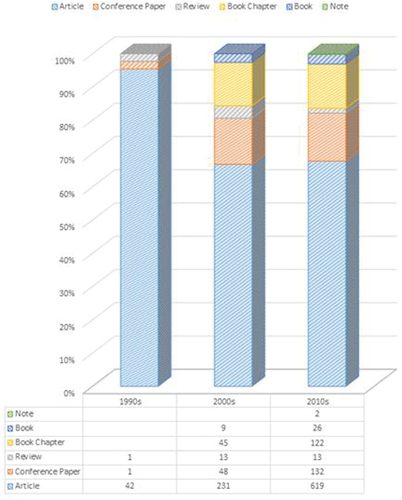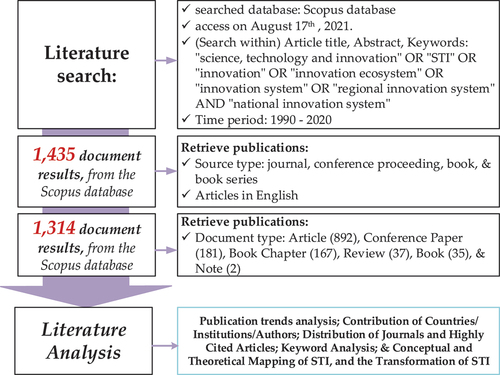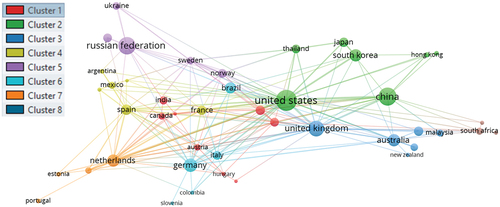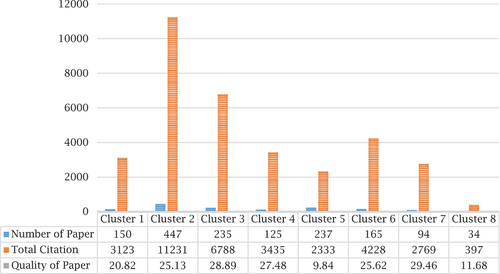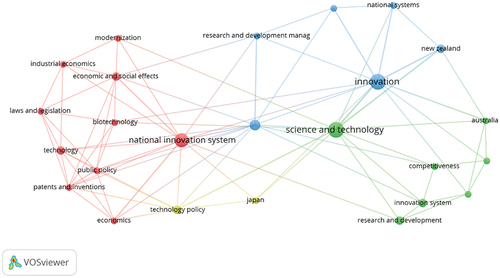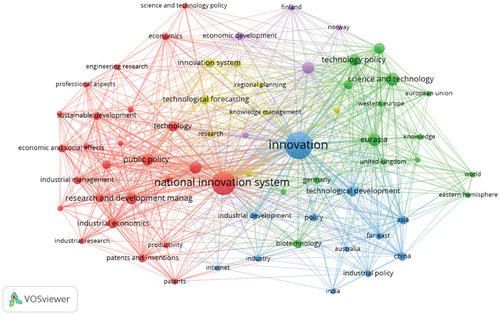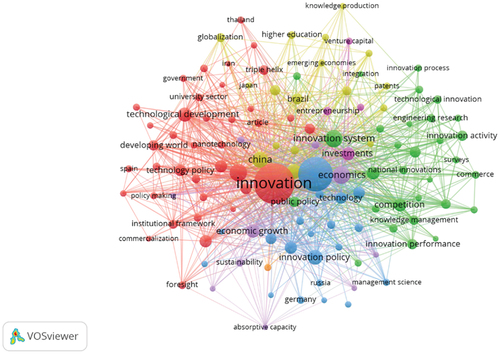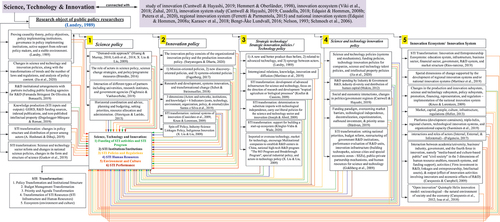Abstract
Science, Technology, and Innovation (STI) topic has become one of the most debatable discourses in the international journals. In the Scopus database, 24,034 documents were recorded as the results when navigating the publications under the STI theme. However, this study limits the bibliometric analysis of the STI topics within the National Innovation System (NIS) framework. In addition, the limitation of the time period is from 1990 to 2020. This study utilizes the literature analysis sourced from the Scopus database and the visualization was performed by utilizing VOSviewer version 1.6.17. The results indicate that 1) STI within the NIS framework has presented a growing topic which becomes the concern to researchers worldwide since the 1990s (44 publications) increasing to 1.314 publications (total publications) until the end of 2020; 2) the United States is regarded as the country of origin for the author’s most published affiliation (171 articles); 3) the United Kingdom has demonstrated better paper quality, which is 50.22, based on total citations to total paper; 4) Universitetet i Oslo is recorded as the institution with the most publications; 5) approximately 2,324 authors, either individual or in group are recorded in publishing papers for the last three decades; 6) Wonglimpiyarat, J. of the Massachusetts Institute of Technology, Department of Aeronautics and Astronautics, Cambridge, United States, is regarded as the most productive author; 7) Research Policy has been referred as the journal publishing the most under this topic; and 8) approximately 44 publications are recorded in the 1990s, 345 are in the 2000s, and 925 are in the 2010s.
PUBLIC INTEREST STATEMENT
This study purposely highlighted the STI area as the main keyword, along with considering innovation, innovation ecosystem, innovation system, regional innovation system, and national innovation system as the other key mirrors. In this paper, a bibliometric analysis is carried out to explore the development of literature on STI research within the National Innovation System (NIS) framework, which has been carried out by researchers around the world and published over the last three decades (1990s-2020s).
1. Introduction
Six aspects have been recorded, thereby inviting a concern when discussing science, technology and innovation (STI), which comprises causality theory, policy objectives, policy implementing institutions, governance in policy implementing institutions, active support from relevant policy-makers, and a stable environment (Landry, Citation1989). Particularly in its development, the study of science and technology systems and innovation has been associated with the study of innovation (Cantwell & Hayashi, Citation2019; Hemmert & Oberländer, Citation1998; Nieminen et al., Citation2016), innovation ecosystem (Viki et al., Citation2018; Zuhal, Citation2013), innovation system study (Cantwell & Hayashi, Citation2019; Casadella, Citation2018; Edquist & Hommen, Citation2008b; Putera et al., Citation2020), regional innovation system (Ferretti & Parmentola, Citation2015) and national innovation system (Edquist & Hommen, Citation2008a; Karasev et al., Citation2018; Bengt-Åke Bengt-Åke. Lundvall, Citation2016; Nelson, Citation1993; Schmoch et al., Citation2006).
The causality is further related to the three theories of science and technology and innovation. First, science policy refers to the greater spending in research institutions automatically translated as innovation (this model is acknowledged as a linear model; Landry, Citation1989). Science policy in China is implemented through a “demand-side approach” (Xielin Xielin Liu & Liu, Citation2009), in which the research funding for basic and applied research is higher than that for technology development. Science policy has been inseparable from the role of actors in science policy, science change strategies, and policy or program implementation steps (Brandão, Citation2016), horizontal coordination and advice, planning and budgeting, priority setting, resource allocation and administration (Henriques & Larédo, Citation2013). In addition, the experience of Russia provides a valuable lesson that the growing trend regarding the number of Russian publications emerges along with the extraordinarily growing number of authors. This realm is due to the reform of the science and technology sector and changes in national science policies as well as the changes in the form and structure of science (Guskov et al., Citation2019). Science policy has been widely disclosed in a number of previous studies, including research on climate change adaptation (Leith et al., Citation2018) and the Human Genome Project (Huang & Murray, Citation2010).
Second, innovation policy emerged in the 1970s emphasizing that innovation development serves as an important aspect in addition to large funding support for research and development (Landry, Citation1989). Innovation policies are perceived from the three classifications, which include 1) mission-oriented policies, 2) new invention-oriented policies, and 3) systems-oriented policies (Fagerberg, Citation2017). In addition, there are the three frameworks focused on innovation policy, which include research and development, innovation systems and transformational change (Schot & Steinmueller, Citation2018). This conception is implemented in a number of researches, such as in analyzing the relationship between innovation policy and MSME performance (Suryanegara & Dharta, Citation2020), and science, technology and innovation systems of small national economies (Nieminen et al., Citation2016). Particularly in China, innovation policy has been implemented through various policies, such as spin-off policy, industry-science linkages policy and indigenous innovation (Xielin Xielin Liu & Liu, Citation2009).
Third, strategic technology, also acknowledged as strategic innovation policy or technology policy, was developed in the 1980s, assuming that greater spending with the appropriate technology strategy is capable of enhancing the productivity and stimulating the economic growth (Landry, Citation1989). The third model is characterized by 1) new and better products than before, 2) relation to the advanced technology, and 3) synergy between actors. Further, technology policy in China is implemented through technology import, market for technology, encouraging multinational companies to establish R&D centers in China, national high-tech R&D program entitled “The 863 Program and Breakthrough Program”, special industrial policy, and actors in technology policy (Xielin Xielin Liu & Liu, Citation2009).
To date, the three concepts have been currently discussed and developed in the area of research. However, this study analyzed the bibliographic characteristics and contents of the paper (Putera et al., Citation2020; Widianingsih et al., Citation2021), from authors across various countries conducting research on STI within the framework of a national innovation system for 30 years, from 1990 to 2020. Specifically, the researchers of this study could contribute to add the research dynamics in the STI area over the last three decades, as this study observed the trend of changes and the number of laws and regulations concerning science and technology and innovation through analyzing the content of its policies (Jia et al., Citation2020). The content analysis of the policy is classified into five different aspects, such as science and technology policies (systems and mechanisms), funding policies, technology innovation policies for companies, science and technology talent policies, and intellectual property policies. In addition, research and development institutional arrangements with partners including public funding institutions for research and development are also included in the development of science and technology and innovation (De Oliveira & Bonacelli, Citation2019).
This study purposely highlighted the STI area as the main keyword, along with considering innovation, innovation ecosystem, innovation system, regional innovation system, and national innovation system as the other key mirrors. Hence, all of these concepts are highly relevant to our bibliometric search strategy.
In this paper, a bibliometric analysis is carried out to explore the development of literature on STI research within the National Innovation System (NIS) framework, which has been carried out by researchers around the world and published over the last three decades. The findings of this paper will reveal an overview of STI research within the NIS framework. This information can interest other researchers to get an overview of this research area for future research. Our research questions include:
What are the general information and annual growth trend of publications related to STI research within the NIS framework over the past three decades?
How is the distribution of sources of Publications and Publications with the Most Citations related to STI research within the NIS framework for three decades?
What has been the evolution of STI research within the NIS framework over the past three decades?
How are Conceptual and Theoretical Mapping of the STI and Transformation of the STI?
2. Data collection and methodology
This study implements a full literature study from the database and is regarded as descriptive research, based on the results of VosViewer (Eck et al., Citation2011). Prior relevant studies have been conducted and developed to navigate the evolutionary study of watershed governance research (Widianingsih et al., Citation2021), global solid waste management (Rahaman et al., Citation2021), global management and public policy research (Putera et al., Citation2021) as well as to evaluate the research productivity in the domain of digital evidence (Chhtrapati et al., Citation2021), digital government and regulation (Putera & Gustina, Citation2021), bibliometric analysis and, in the sense that technological advances are aligned with management systems, whether public or private (Abad-Segura & González-Zamar, Citation2020), ontology engineering (Wu & Ye, Citation2021), and big data and policy (Putera & Pasciana, Citation2021). The performed steps and protocol of this study are illustrated in .
This study referred to the article retrieved from the Scopus database on 17 August 2021. The research strategy employed the Boolean operator search operation, which included (TITLE-ABS-KEY (“science, technology and innovation”) OR TITLE-ABS-KEY (“STI”) OR TITLE-ABS-KEY (“innovation”) OR TITLE-ABS-KEY (“innovation ecosystem”) OR TITLE-ABS-KEY (“innovation system”) OR TITLE-ABS-KEY (“regional innovation system”) AND TITLE-ABS-KEY (“national innovation system”)) AND PUBYEAR > 1989 AND PUBYEAR < 2021 AND (LIMIT-TO (LANGUAGE, “English”)) AND (LIMIT-TO (SRCTYPE, “j”) OR LIMIT-TO (SRCTYPE, “b”) OR LIMIT-TO (SRCTYPE, “p”) OR LIMIT-TO (SRCTYPE, “k”)) AND (LIMIT-TO (DOCTYPE, “ar”) OR LIMIT-TO (DOCTYPE, “cp”) OR LIMIT-TO (DOCTYPE, “ch”) OR LIMIT-TO (DOCTYPE, “re”) OR LIMIT-TO (DOCTYPE, “bk”) OR LIMIT-TO (DOCTYPE, “no”)) .
Based on a search from the Scopus database, approximately 1,314 articles were navigated upon the completion of two stages; in the first stage, it was based on “Article title, abstract, Keywords” with keywords and restrictions on the paper publication year from 1990 to 2020, thereby obtaining 1,435 articles. Further, in the second stage, the navigation was restricted to documents in English, limited to “Source type” generated from journals, conference proceedings, books, and book series. In this second stage, Articles (892), Conference Papers (181), Book Chapters (167), Reviews (37), Books (35), and Notes (2) were obtained, further analyzed by performing the VOSviewer version 1.6.17 software.
3. Results and discussion
3.1. General information and growth trend
In the last 30 years since 1990, a growing number of publications were under the STI topic within the framework of the national innovation system (). The Scopus database has recorded that the 44 articles were published in the 1990s period, increasing by 7 times at the end of the 2000s (2009) with a total of 345 articles. In addition, the number of publications in the 2000s period was still far less than in the 2010s decade gathering 925 articles. This navigation indicates that the STI topic within the framework of the national innovation system continues to grow, attracting the attention of researchers worldwide. This condition is obviously marked from the distribution of the author’s country of origin (), as many as 126 countries with the United States as the author’s country of origin for publishing the most articles (171 articles), followed by China (124 articles), and the Russian Federation (116 articles). The results are indifferent when viewed based on the citation of the published publications. The United States was recorded as the country with citations to publications in the STI topic with the most citations (6,905 citations), followed by the United Kingdom (4,771 citations), and Germany (2,439 citations). Meanwhile, the paper quality was based on the total citation of the total paper, indicating that the paper from the United Kingdom had a better quality denoted with 50.22, followed by Spain (43.93), and the United States (40.38). This condition further indicates that a large number of publications have not determined the citation level for publications and the quality of these publications. The United States became the country with citations to publications under the STI field with the most citations (6,905 citations), followed by the United Kingdom (4,771 citations), and Germany (2,439 citations).
Figure 2. Trends in science, technology, and innovation publication in national innovation system studies in the last three decades.
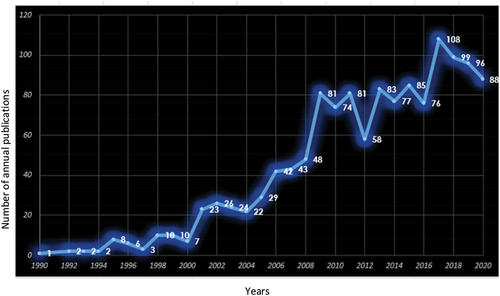
The results of the bibliometric analysis () indicate that there are eight clusters formed based on the affiliation of the researcher’s country of origin. Cluster 1 has eight countries, denoting a network of researchers, which include Austria, Canada, Denmark, Finland, Hungary, India, Lithuania, and Switzerland. The strength of this cluster is relatively similar, indicated by the red nodes, which have a relatively similar circular diameter between one another. Cluster 2 includes the seven countries interconnected by this network, including China, Hong Kong, Japan, Singapore, South Korea, Thailand, and the United States. Cluster 2 contains the two countries with larger nodes than network members in this cluster, including the United States and China, which are more dominant, followed by South Korea and Japan. Further, Cluster 3 contains the six countries within the network, comprising Australia, Iran, Malaysia, New Zealand, Taiwan, and the United Kingdom.
Cluster 3 is dominantly occupied by nodes from the United Kingdom, Australia, and Taiwan. Cluster 4 contains the six countries that have networks, which are Argentina, Chile, France, Mexico, Spain, and Uruguay. In this cluster, the Spain and France nodes appear to be larger than the countries in Cluster 4 network. Similarly, Cluster 5 has six countries in its network, including Kazakhstan, Norway, Poland, Russian Federation, Sweden, and Ukraine. The Russian Federation has the largest nodes in this cluster; thus, its presence is obviously visible not only in Cluster 5 but also among other clusters. Cluster 6 consists of five countries, including Brazil, Colombia, Germany, Italy, and Slovenia. Germany and Brazil are the country nodes that are clearly visible in this cluster. Meanwhile, Cluster 7 contains the four countries, including Belgium, Estonia, Netherlands, and Portugal. Only the Netherlands has the largest nodes compared to the other countries in Cluster 7. Lastly, Cluster 8 only contains the three countries in its network, covering Ireland, Nigeria, and South Africa.
Meanwhile, the metadata results () indicate the strength of each country cluster. Cluster 2 was reported to be the most productive cluster with 447 publications from 7 countries from its network, followed by countries from Cluster 5 (237 publications), and Cluster 3 (235 publications). Publications from Cluster 2 similarly indicated the most citations compared to other clusters, reported that the publications from Cluster 2 had been cited for 11,231 times, followed by publications from Cluster 3 with 6,788 citations, and publications from Cluster 6 with 4,228 citations. However, the results are diverse when considering the quality of the paper, where Cluster 7 presented the highest score (29.46), followed by Cluster 3 (28.89), and Cluster 4 (27.48).
Additionally, the bibliometric analysis revealed that there were 2,215 institutions indicating the STI authors’ affiliation over the three decades. This paper presents the top five institutions to which researchers publish the STI topics within the NIS framework (). The top 5 affiliate institutions are based on the issued total papers (TP), indexed by Scopus.
Table 1. Top 5 affiliate institutions researching “STI” topic
Universitetet i Oslo was recorded as the institution with the most publications (22 publications), as well as the institution with the most total citations (TC) from the list. The second position was occupied by the National Research University Higher School of Economics with 21 publications and 252 citations. The record was further followed by Thammasat University (with 19 publications and 149 citations), Lunds Universitet (with 19 publications and 410 citations), and in the fifth place was occupied by Seoul National University with 18 publications and 557 citations. Seoul National University was listed as the origin institution of the STI authors’ affiliation, which was the first to publish the STI topic within the framework of an internationally published NIS, as evidenced by its first publication in 2001 entitled “Technological Innovation Survey of Manufacturing Firms: The Case of Korea” (Park et al., Citation2001). This publication was recorded far before the four recorded institutions in the top 5 list of first publications, indexed in Scopus international journals.
The database recorded 2,324 authors, either individually or in groups, in publishing papers under the STI topic within the NIS framework over the last three decades. The top 5 authors are presented in , presenting that Wonglimpiyarat, J. from the Massachusetts Institute of Technology, Department of Aeronautics and Astronautics, Cambridge, United States was the most prolific in publishing 16 papers and has been cited 139 times. The data is followed by Fagerberg, J. from Universitetet i Oslo, TIK Centre, Oslo, Norway with 14 publications, which has been cited for 561 times. However, the number of citations published by Fagerberg, J. remains under those authored by Mowery, DC of the UC Berkeley Haas School of Business, Berkeley, United States. Although Mowery, DC is ranked at the 4th in the Top 5 most prolific publishing STI articles, but the 10 publications has been cited for 774 times. This description also indicates that the large number of publications does not reflect the high citations.
Table 2. Top 5 authors researching the “STI” topic based on the number of published papers
3.2. Source of publications and publications with the most citations
Based on metadata, 649 publication sources were recorded, providing the place for publishing papers under the STI topic within the NIS framework over the past three decades. The 649 publication sources had published: Articles (892 titles), Conference Papers (181 titles), Book Chapters (167 titles), Reviews (37 titles), Books (35 titles), and Notes (2 titles). The top 5 Sources of the STI publications was based on the publication number, illustrated in . Three of the top five journals were published by Elsevier, while the rest were published by Oxford University Press and Taylor & Francis.
Table 3. Top 5 sources of the STI publications based on number of publications
The Research Policy was recorded as the journal that published the most STI topics within the NIS framework (with 58 articles), which has been cited for 8,885 times. It was recorded that Research Policy as the journal publishing the most STI topics within the NIS framework, indicated a proven and a high number of citations as this journal specialized in publishing articles with the following subjects:
Economics of Innovation/Technology/Science; Entrepreneurs/Entrepreneurship; Evolutionary or (neo-) Schumpeterian Economics; Geography of Innovation - e.g., industrial clusters; Indicators - science, technology, R&D, innovation etc.; Innovation and Sustainability; Innovation Management/Organization/Policy /Strategy; Innovation Systems - national, regional, sectoral, technological; Knowledge - creation/production, diffusion/transfer/exchange, adoption/ exploitation etc.; Learning (e.g., organizational) and Experimentation; Product and Process Development; Networks - e.g., research/ R&D collaboration, university-industry links, regional clusters, supply chains; Research and Development (R&D) Management/Policy/Strategy; Research Policy; Resource-Based View of the Firm - competence/capability (e.g., absorptive, core, dynamic); Science Policy; Sociotechnical Paradigms/Regimes; Technological Paradigms/Trajectories; Technological problem-solving; Technology Management/Policy/Strategy. (Elsevier, Citation2021)
All of the aforementioned subjects are under the STI topics, thereby emphasizing that this journal is regarded as the most published articles under the STI topics in NIS.
Meanwhile, from the 1,314 publications under the STI topics in NIS framework during 1990–2020, approximately 25,277 articles were cited. describes the Top 5 Articles under the STI topics with the most citations. In particular, the article entitled “Regional innovation systems: Institutional and organizational dimensions”(Cooke et al., Citation1997) became the most cited article (1,245 citations), followed by “The determinants of national innovative capacity” (Furman et al., Citation2002) with 1,086 citations. Therefore, from the Top 5 articles, it is apparent that the four articles with the most citations were retrieved from the “Research Policy” journal, which is in accordance with the previous findings confirming that “Research Policy” was regarded as the most dominant publication source for the three decades.
Table 4. Top 5 articles under the STI topics with the most citations
3.3. Three decades of STI study
The development and evolution of the STI studies within the NIS framework over the last three decades serves as the rationale for this research. The dynamics of these developments, when quantitatively studied, were inseparable from the publication development trend in each decade. There were 44 publications during the 1990s, 345 publications in the 2000s era, and 925 publications in the 2010s.
Period I (1990s) as presented in and indicates that there are 4 clusters. Cluster 1 (in red) indicates 10 nodes with a focus on the national innovation system, economic and social effects and technology. Cluster 2 (green) presents 7 nodes with a focus on science and technology, competitiveness, and research and development. Cluster 3 (in blue) demonstrates 6 nodes with a focus on innovation, technology transfer and R&D Management. In addition, Cluster 4 (yellow) only marks 2 nodes with a focus on technology policy.
Table 5. Research topic entitled STI in the NIS framework and list of leading papers of each cluster
apparently describes that, in the 1990s, the United States was recorded as the country with the most publications on the STI topics within NIS framework, with 9 publications, followed by the UK (4 publications), and Canada (3 publications). In terms of author category, it was recorded that Mowery, DC from UC Berkeley Haas School of Business, Berkeley, United States, became the author, mostly published topic under the STI area with three publications, followed by Johnston, R. from the University of Sydney, Australian Center for Innovation, Sydney, Australia, as well as Ray, T. from the Open University Business School, Milton Keynes, United Kingdom, with two publications, respectively. When viewed through the affiliation, both the University of Sussex, University of California, Berkeley, and UC Berkeley Haas School of Business had each three publications under this area.
Table 6. Top 3 authors, institutions, countries, and source titles in each decade of the STI studies within NIS framework (1990–2020)
Period II (2000s) as presented in and apparently describes that there are 5 clusters. Cluster 1 (colored red) indicates 25 nodes with a focus on national innovation system, R&D management, industrial economics, public policy, and technology transfer. Cluster 2 (green) indicates 15 nodes with a focus on science and technology, technology policy, innovation policy, and biotechnology. Cluster 3 (in blue) indicates 12 nodes with a focus on innovation, technology development, and industrial policy. Cluster 4 (colored yellow) contains 8 nodes with a focus on technological forecasting, innovation system, and regional innovation system. In addition, Cluster 5 (purple) presents 5 nodes with a focus on research and development, competitiveness and economic development.
In this period, new issues emerged from the STI topic within NIS framework, widely discussed, thereby attracting various concerns in studies, including technological development, biotechnology, technological forecasting, as well as policy issues such as the growing number of public policy studies under the STI area and innovation policy. During this period, regional innovation systems were also discussed. In addition to new issues, there were a number of issues to be discussed in the 1990s, further attracting concerns in the 2000s, including R&D Management, technology policy, and industrial economics.
In the 2000s (), the productivity of authors with affiliation from the United States excels in publishing 56 articles, followed by the UK (35 publications), and Germany (24 publications). If viewed based on the origin of affiliation, universities such as Seoul National University, Aalborg University, and University of California, Berkeley were recorded as the most productive countries in producing publications under the STI topic within NIS framework, with each publishing 8 articles. During this period, Chung, S. from Sejong University Graduate School of Business, Institute for Technological Innovation, Seoul, South Korea, and Mowery, DC from UC Berkeley Haas School of Business, Berkeley, United States, were regarded as the most productive authors with their respective five publications, followed by Dunlap, DD from Purdue University, College of Technology, West Lafayette, United States with four publications. Regarding the source title, Research Policy is listed as the journal that publishes the most STI topics within NIS framework in this period, with 32 publications, followed by Science and Public Policy (13 publications), and the International Journal of Technology Management (11 publications).
Period III (2010s) as presented in and apparently indicates that there are 7 clusters. Cluster 1 (in red) indicates 38 nodes with a focus on innovation, research and development, technology development, technology policy, science and technology, economic development, and the triple helix. Cluster 2 (in green) contains 30 nodes with a focus on innovation systems, societies and institutions, public policy, sustainable development, innovation performance, and competition. Cluster 3 (colored blue) consists of 20 nodes with a focus on the national innovation system, innovation policy, developing countries, competitiveness, management science and regional innovation system. Cluster 4 (yellow) contains 17 nodes with focuses on technology transfer, China, knowledge, intellectual property rights, and knowledge production. Cluster 5 (colored purple) contains 10 nodes with focuses on economic growth, and the knowledge economy. Cluster 6 (colored pink) presents 4 nodes with focuses on investments, entrepreneurship, and venture capital. In addition, Cluster 7 (orange) only presents 1 node with a focus on biotechnology.
During this period, new issues began to emerge under the STI topics within NIS framework, widely discussed; thereby attracting various concerns in studies, which include the triple helix, societies and institutions, sustainable development, innovation performance, developing countries, management science, intellectual property rights, knowledge economy, entrepreneurship, and knowledge production.
In the 2010s (), the dominance of the United States during 1990–2009 in publishing articles on the topic of STI within the NIS framework was replaced by the Russian Federation, producing 115 publications, followed by the United States (106 publications), and China (102 publications). When viewed by the affiliation, the authors from the National Research University Higher School of Economics were regarded as the most productive author by publishing 20 articles, followed by Universitetet i Oslo (17 publications), and Thammasat University (17 publications). Thus, Wonglimpiyarat, J. from the Massachusetts Institute of Technology, Department of Aeronautics and Astronautics, Cambridge, United States, became the most author publishing article (15 publications), followed by Fagerberg, J. from Universitetet i Oslo, TIK Centre, Oslo, Norway (11 publications), and Lee, K. from National Research University Higher School of Economics, Moscow, Russian Federation (8 publications). Meanwhile, based on the source title, Technological Forecasting and Social Change leads with 35 publications, followed by Research Policy (23 publications), and Science and Public Policy (13 publications).
3.4. STI Discourse and concepts
Aspects of knowledge production serve as a reference in reviewing science and technology systems and innovation (Degelsegger-Márquez & Remøe, Citation2019). Knowledge production includes inputs and outputs such as the comparison between Gross Domestic Expenditure in Research and Development (GERD) with Gross Domestic Product (GDP), the comparison sources of funding or investment from research and development typically consisting of the government and the private sector, the number of publications in international journals indexed by Scopus or Web of Science, and the amount of intellectual property excluding the written work (patents, industrial designs, etc.).
In general, science and technology and innovation systems highlight the relationship among the regions, knowledge, innovation and diffusion, as well as the spatial dimensions of change, supported by the development of regional innovation systems and/or national innovation systems (Martínez et al., Citation2019). In addition, science and technology systems and innovation are not only pivotal for economic competitiveness at the local or national level but also provide basic productivity growth for the industry. Spending on research and development by both industry and research and development institutions along with industry diversity and distribution of human capital thus affect the innovation and productivity (Mukim, Citation2012). As a system, science and technology and innovation engage both social and economic interactions in order to maintain the system sustainability provided with a knowledge base in a society or community. Therefore, science and technology and innovation are projected to experience changes in accordance with social developments, firmly prompted by transformations in politics/government regimes (Cantwell & Hayashi, Citation2019).
In particular, transformations in science and technology systems and innovation are typically influenced by Innovation and Entrepreneurship Ecosystems (Rios-ramirez, Citation2019), where elements of the education system, infrastructure, business sector, financial sector, government, R&D system, and market structure serve as the determining aspects. Another view suggests that the national system of innovation is significantly decisive in the transformation of the science and technology system and innovation (Cassiolato et al., Citation2009). Further, such transformations include the three subsystems, which are as follows: (1) the production and innovation subsystem, contemplating the structure of economic activity, the distribution of sectors, the degree of informality and regional distribution and size, the level and quality of employment, and the conducted types of innovations; (2) the science and technology subsystem, which includes education (basic to higher), research, training, and elements of science and technology infrastructure, such as information, scientific databases, metrology, and intellectual property; and (3) the subsystem of policies, promotions, financing, representation and regulations, intended for the public and private sectors to improve the innovation system. This condition occurs in South Africa, where the transformation is marked by the implementation of a national innovation system (Glenda Kruss & Lorentzen, Citation2009).
A number of countries such as Iran have made changes to the policy structure and distribution of power among actors to develop their science and technology systems and innovations (Heshmati & Baji, Citation2019). In Vietnam, the government has aggressively provided support in creating an ecosystem for start-ups (Klingler-Vidra & Wade, Citation2020), this effort is conducted by issuing pro-industry and start-up policies such as the 2013 regulation, providing incentives for companies conducting R&D, and the Vietnamese ministry of science and technology establishing the “Vietnam Silicon Valley Project”. Further in 2015, the TechFest Vietnam was undertaken as an annual event to encourage the start-up ecosystem and the provision of a national technology innovation fund. In 2016, the government through the prime minister of Vietnam established 844 start-ups by 2025, in addition to regulations in the form of regulations that support SMEs in obtaining tax incentives, access to credit, and support for accounting books.
In Brazil, the changes particularly occurred along with the arrangement for the development of sophisticated infrastructure for science and technology in numerous research and development institutions and universities. In addition, the direction of research and development of “tropical agriculture or biological processes” presents another factor in Brazil (Koeller & Cassiolato, Citation2009). Similarly in Russia, transformations in the science and technology and innovation sectors were conducted along with transformations in seven areas, including setting of national priorities, budget reform, rearrangement of government R&D institutions, performance evaluation of R&D units, innovation infrastructure (building technoparks, science cities and special economic zones (SEZs), public–private partnership mechanisms, and human resources for science and technology (Gokhberg et al., Citation2009).
Specifically, in the India experience, the transformation occured after experiencing a number of phases. The first phase includes the determination to substitute imports with technological independence. Steps were undertaken by promoting R&D results, immediately pursuing independence simultaneously, and providing access to various kinds of overseas technology. In the second phase, India further implemented a liberal policy concerning the science and technology sector and innovation, such as Internal Liberalization (1980–1990), by providing incentives to the private sector to improve industrial facilities, importing technology and removing control from the government. In addition, external liberalization (since 1991) was executed by opening access market for various industries in India without government intervention, enabling the companies in India to partner with overseas companies of their own preference (Joseph & Abrol, Citation2009).
Referring to Chinese experience (Băzăvan, Citation2019), the seven dimensions were observed regarding the policy of innovation system regulations, including funding paradigm, efforts to overcome market barriers, efforts to create technological independence, decentralization, experimentation, outward investment (the “Go Global” policy in 2005 to encourage Chinese companies for overseas investment), and determination of priority areas. The Brazil case, however, presents a difference (Dos Santos E Silva et al., Citation2019), the employed innovation system approach was a sectoral innovation system, especially in the sugar energy system, involving the six driving and inhibiting factors that affect the three dimensions of innovation (actors and networks, institutions, and knowledge), comprising 1) Cost, which affects the three dimensions, for example, the impact of taxes will affect the incurred costs by the institution, the bargaining power of suppliers related to actors and networks; 2) Technology, related to technological opportunities/challenges, engaging research or innovation on certain topics; 3) Environment, determining the internal and external environment system; 4) Organization, related to the characteristics/managerial of the organization, involving the actors and networks, by implementing the organizational design in sectoral innovation systems, 5) Policies, related to actions in the regulatory environment and linked to institutions within the system; and 6) External Factors, related to uncontrolled factors, excluding the existing categories.
The innovation system thus becomes an inseparable aspect of the science and technology system and innovation, further connected to platforms (development containers), triple-helix, regional clusters, technological innovation systems, and organizational capacity (Suominen et al., Citation2019), along with national and regional innovation system (Pucci et al., Citation2018). Meanwhile in some cases, innovation systems assist in understanding social problems such as adjustments in health care, energy systems, and others. Interaction between different types of partners, including universities, research institutes and government agencies, is deemed important (Yaghmaie & Vanhaverbeke, Citation2019). Another example includes a prior study by Leiden Bioscience Park (Fulgencio, Citation2017), pointing out that the innovation system is formed from the interactions and roles of actors as part of the system, thereby forming different social values. In the case of Leiden Bioscience Park, the involvement of actors or stakeholders was categorized into three groups: 1) Internal, referring to a group of actors directly connected with Leiden Bioscience Park, such as government (local/national), local universities, project partners, and tenants; 2) External, referring to a group of actors with an interest in the development of Leiden Bioscience Park without investments in the area, such as the restaurant and hotel business; 3) Infexternal, referring to a group of actors serving as the future internal or external stakeholders of the region.
In the development of the innovation system, the six key elements are required, including market (trade balance of technological goods), capital (Research & Development Expenditures % GDP compared to Researchers in R&D—per million people), people (human resources in the fields of science and technology and innovation such as researchers and S2 and S3 students), culture (in the form of perspective on science and technology and innovation), infrastructure (in the form of quality and accessibility of communication and IT systems, availability of logistics for the movement of research and innovation products, accommodating a community for innovative entrepreneurs to enhance the sharing of ideas and the administrative and legal services for startup companies) and regulations (related to regulations stipulated by the government in an effort to drive startups or an innovation climate; Heller, Citation2013).
In another study, the innovation system is perceived from the interaction pattern and the role of the actor in “the Quadruple Innovation Helix (QIH)” under the three dimensions of innovation (Carayannis, Goletsis et al., Citation2018). QIH includes academia/university, business/industry, government, and the fourth force in innovation, involving “media-based and culture-based public” and “civil society” (Carayannis & Campbell, Citation2009). The three dimensions include:
Enablers, as the main driver of innovation performance in the form of human resources (recent doctoral graduates, population level aged 30–34 with tertiary education graduates, and adolescents with senior secondary education), research systems (international scientific publications, the top 10% of most popular and widely cited publications), and overseas doctoral students), and funding support (research and development spending in the public sector, and venture capital investment),
Activities, as the effort dedicated to drive innovation, such as corporate investment (investment for R&D, and other than R&D), linkages and entrepreneurship (innovative SMEs that are fostered, and collaboration of Innovative SMEs with Universities/R&D/Private Institutions), and intellectual assets (amount of patent applications, PVP, trade secrets, and copyrights), and
Outputs, as the effect of innovation activities that include innovators (technology-based startups born from universities/R&D institutions, the amount of intellectual property accepted by the market), and economic effects (economic success of innovation in job creation, types of technology exports, and licenses from intellectual property).
Quadruple helix in some countries is further acknowledged as the Penta Helix innovation model, mapping the interactions between actors, such as government—social organizations—education—society—private sector (Deliana et al., Citation2017), social entrepreneurs—public—private—civil society—academics (Halibas et al., Citation2017), scholars—business/businessmen—government—community—media (Sudiana et al., Citation2020a, Citation2020b), environment—industry—government—academia—society (Cabrera-Flores et al., Citation2020), private sector—universities—government—media—environment (Hardianto et al., Citation2019), and government—business—society—academia—environment (Romero-Rodríguez et al., Citation2020).
In recent developments, the innovation system has initiated to adopt “open innovation” by adopting the quintuple helix (Carayannis et al., Citation2012; Carayannis, Grigoroudis et al., Citation2018; Grundel & Dahlström, Citation2016; Issa et al., Citation2018). The Quintuple Helix emphasizes the necessary socio-ecological transition of society and the economy in the twenty-first century. In addition, within the framework of the Quintuple Helix innovation model, the natural environment of society and the economy serves as a driver of knowledge production and innovation to determine opportunities for the knowledge economy (Carayannis & Campbell, Citation2019).
All of these things are good lessons in understanding the transformation of STI. Diagrammatically, the conceptual and theoretical mapping of the science and technology system and innovation, and the transformation of science and technology and innovation can be seen in .
Based on conceptual and theoretical mapping (), it is thus concluded that STI involves a group of interrelated elements, formed by the interaction of science and technology institutions and innovation, science and technology and innovation policies and regulations, funding for STI activities and programs, STI human resources, and performance of the STI. Based on this definition, the five concepts from STI include 1) Funding for the implementation of science and technology and innovation activities, and science and technology and innovation activity programs; 2) Institutions of science and technology and innovation; 3) Policies and Regulations of science and technology and innovation; 4) Human Resources in the sector of science and technology and innovation, environment and culture, and 5) Performance of science and technology and innovation.
4. Conclusions
Based on the results of bibliometric analysis, it is concluded that: First, the trend of STI publications within NIS framework in the last three decades has significantly increased, in which during the 1990s there were only 44 publications, which was different compared to the late 2010s decade, generating 925 publications, indicating an increase of 21 times compared to the total publications in the 1990s period. Second, the large number of publications has not determined the citation and the quality level for publications. This finding emerged in the United States as the country of origin for the author’s affiliation with the most produced articles (171 articles), with the most citations (6,905 citations). However, in terms of the publication quality of the resulting papers, the number of citations from the total paper remains under the United Kingdom (50.22), and Spain (43.93). In addition, the United States indicates 40.38 regarding the paper quality level. Third, Cluster 2 consists of researchers with affiliations from China, Hong Kong, Japan, Singapore, South Korea, Thailand, and the United States as countries with the most publications out of 7 other clusters, with 447 publications and 11,231 citations. Fourth, Universitetet i Oslo, National Research University Higher School of Economics, Thammasat University, Lunds Universitet, and Seoul National University are recorded as the author’s home institutions that publish the most articles under the STI topics within NIS framework. Fifth, Wonglimpiyarat, J., Fagerberg, J., Intarakumnerd, P., Mowery, DC, and Lee, K. are regarded as the authors who published the most articles compared to 2,324 other authors who had published under similar topic. Sixth, Research Policy, Technological Forecasting and Social Change (Formerly recognized as: Technological Forecasting), Science and Public Policy, Technology Analysis and Strategic Management, and Technovation are recorded as the journals that publish the most articles related under the STI topics within NIS framework.
In addition, conceptual and theoretical mapping resulted in a new concept regarding the transformation of STI policy as a form of movement/change towards a science and technology system and innovation, considered better supports for improving the Indonesia performance and competitiveness, which includes areas such as: policies and institutional structures, budget management, priorities and agendas, and science and technology and innovation resources. Referring to this concept, the transformation of the STI system includes 1) transformation of science and technology and innovation policies and institutional structures; 2) science and technology and innovation budget management, 3) science and technology and innovation priorities and agendas/programs, 4) resources (human resources and infrastructure) from science and technology and innovation, and 5) ecosystem including environment and culture.
Disclosure statement
No potential conflict of interest was reported by the author(s).
Additional information
Funding
Notes on contributors

Prakoso Bhairawa Putera
Prakoso Bhairawa Putera is a Doctoral Student in Programme of Administrative Sciences (Padjadjaran University); Head of Bureau for Planning and Finance; & Senior Researcher in the field of Policy and Administration in Badan Riset dan Inovasi Nasional Republik Indonesia.
Suryanto Suryanto
Suryanto is lecturer at the Department of business Administration, Faculty of Social and Political Sciences, Universitas Padjadjaran, Bandung-Indonesia. Main research interests are business administration, Fintech, and entrepreneurship.
Sinta Ningrum
Sinta Ningrum is lecturer at the Department of Public Administration, Faculty of Social and Political Sciences, Universitas Padjadjaran, Bandung-Indonesia.
Ida Widianingsih
Ida Widianingsih, is an associate professor at Public Administration Department and Vice Dean for Learning, Student, and Research Affairs of the Faculty of Social and Political Sciences, Universitas Padjadjaran (Unpad), Indonesia.
Yan Rianto
Yan Rianto is Deputy for Research and Innovation Infrastructure, Badan Riset dan Inovasi Nasional Republik Indonesia. He got PhD from Tokai University (Japan).
References
- Abad-Segura, E., & González-Zamar, M. D. (2020). Research analysis on emerging technologies in corporate accounting. Mathematics, 8(9), 1–23. https://doi.org/10.3390/math8091589
- Autio, E., Kenney, M., Mustar, P., Siegel, D., & Wright, M. (2014). Entrepreneurial innovation: The importance of context. Research Policy, 43(7), 1097–1108. https://doi.org/10.1016/j.respol.2014.01.015
- Băzăvan, A. (2019). Chinese government’s shifting role in the national innovation system. Technological Forecasting and Social Change, 148(August), 119738. https://doi.org/10.1016/j.techfore.2019.119738
- Brandão, T. (2016). Shaping Portuguese science policy for the European horizon: The discourses of technological change. Technological Forecasting and Social Change, 113(Part B), 168–184. https://doi.org/10.1016/j.techfore.2015.09.014
- Cabrera-Flores, M., López-Leyva, J., Peris-Ortiz, M., Orozco-Moreno, A., Francisco-Sánchez, J., & Meza-Arballo, O. (2020). A framework of penta-helix model to improve the sustainable competitiveness of the wine industry in Baja California based on innovative natural resource management. E3S web of conferences, 167. https://doi.org/10.1051/e3sconf/202016706005
- Cantwell, J., & Hayashi, T. (2019). Paradigm shift in technologies and innovation systems (J. Cantwell & T. Hayashi, eds.). Springer Nature Singapore Pte Ltd.
- Carayannis, E. G., Barth, T. D., & Campbell, D. F. J. (2012). The Quintuple Helix innovation model: Global warming as a challenge and driver for innovation. Journal of Innovation and Entrepreneurship, 1(2), 72–73. https://doi.org/10.1504/IJTM.2009.023374
- Carayannis, E. G., & Campbell, D. F. J. (2009). ‘Mode 3 and ‘Quadruple Helix : Toward a 21st century fractal innovation ecosystem. Int. J. Technology Management, 46(3/4), 201–234. https://doi.org/10.1504/IJTM.2009.023374
- Carayannis, E. G., & Campbell, D. F. J. (2019). Smart quintuple helix innovation systems: How social ecology and environmental protection are driving innovation, sustainable development and economic growth. Springer Nature Swizerland AG. https://doi.org/10.1007/978-3-030-01517-6_6
- Carayannis, E. G., Goletsis, Y., & Grigoroudis, E. (2018). Composite innovation metrics: MCDA and the Quadruple innovation helix framework. Technological Forecasting and Social Change, 131(June), 4–17. https://doi.org/10.1016/j.techfore.2017.03.008
- Carayannis, E. G., Grigoroudis, E., Campbell, D. F. J., Meer, D., & Stamati, D. (2018). The ecosystem as helix: An exploratory theory-building study of regional co-opetitive entrepreneurial ecosystems as quadruple/quintuple helix innovation models. R and D Management, 48(1), 148–162. https://doi.org/10.1111/radm.12300
- Carlsson, B. (2006). Internationalization of innovation systems: A survey of the literature. Research Policy, 35(1), 56–67. https://doi.org/10.1016/j.respol.2005.08.003
- Casadella, V. (2018). innovation systems in emerging economies: MINT – Mexico, Indonesia, Nigeria, Turkey Vanessa (V. Casadella, ed.). ISTE Ltd and John Wiley & Sons, Inc. Apart.
- Cassiolato, J. E., Maria, H., & Lastres, M. (2009). science, technology and innovation policies in the BRICS countries: An introduction. In J. E. Cassiolato & V. Vitorino (Eds.), BRICS and development alternatives: Innovation systems and policies (pp. 1–34). Anthem Press. https://doi.org/10.7135/UPO9781843318149.004
- Castellacci, F., & Natera, J. M. (2013). The dynamics of national innovation systems: A panel cointegration analysis of the coevolution between innovative capability and absorptive capacity. Research Policy, 42(3), 579–594. https://doi.org/10.1016/j.respol.2012.10.006
- Chhtrapati, D., Chaudhari, S. P., Mevada, D., Bhatt, A., & Trivedi, D. (2021). Research productivity and network visualization on digital evidence: A bibliometric study. Science & Technology Libraries. https://doi.org/10.1080/0194262X.2021.1948486
- Colombo, M. G., & Delmastro, M. (2002). How effective are technology incubators? Evidence from Italy. Research Policy, 31(7), 1103–1122. https://doi.org/10.1016/s0048-73330100178-0
- Cooke, P., Uranga, M. G., & Etxebarria, G. (1997). Regional innovation systems: Institutional and organisational dimensions. Research Policy, 26(4–5), 475–491. https://doi.org/10.1016/s0048-73339700025-5
- Crespi, G., & Zuniga, P. (2012). Innovation and productivity: Evidence from six latin American countries. World Development, 40(2), 273–290. https://doi.org/10.1016/j.worlddev.2011.07.010
- Cunningham, J. A., & Link, A. N. (2014). Fostering university-industry R&D collaborations in European Union countries. International Entrepreneurship and Management Journal, 11(4), 849–860. https://doi.org/10.1007/s11365-014-0317-4
- De Oliveira, F. S., & Bonacelli, M. B. M. (2019). Institutionalization of research administration in Brazil: Some evidences. Journal of Technology Management and Innovation, 14(2), 69–80. https://doi.org/10.4067/s0718-27242019000200069
- Degelsegger-Márquez, A., & Remøe, S. O. (2019). ASEAN’s science, technology and innovation policy: Tension and integration between intergovernmentalism and sub-regional cooperation. Asia Pacific Business Review, 25(5), 637–655. https://doi.org/10.1080/13602381.2019.1652977
- Deliana, Y., Djuwendah, E., Kusnadi, E., & Sendjaja, T. P. (2017). The perception of green marketing: A case in Jatinangor, West Java Province, Indonesia. International Journal of Economic Research, 14(6), 201–216.
- Dodgson, M., Hughes, A., Foster, J., & Metcalfe, S. (2011). Systems thinking, market failure, and the development of innovation policy: The case of Australia. Research Policy, 40(9), 1145–1156. https://doi.org/10.1016/j.respol.2011.05.015
- Dos Santos E Silva, D. F., Bomtempo, J. V., & Alves, F. C. (2019). Innovation opportunities in the Brazilian sugar-energy sector. Journal of Cleaner Production, 218(May), 871–879. https://doi.org/10.1016/j.jclepro.2019.02.062
- Dunning, J. H., & Lundan, S. M. (2009). The internationalization of corporate R&D: A review of the evidence and some policy implications for home countries. Review of Policy Research, 26(1–2), 13–33. https://doi.org/10.1111/j.1541-1338.2008.00367.x
- Eck, N., Van, J., & Waltman, L. (2011). Text mining and visualization using VOSviewer. ISSI Newsletter, 7(3), 50–54.
- Edquist, C., & Hommen, L. (2008a). Chapter 1: Comparing national systems of innovation in Asia and Europe : Theory and comparative framework. In Small Country Innovation Systems. Cheltenham, UK: Edward Elgar Publishing. Retrieved Aug 9, 2021, from https://www.elgaronline.com/view/9781845425845.00007.xml.
- Edquist, C., & Hommen, L. (2008b). Small country innovation systems: Globalization, change and policy in Asia and Europe small country innovation systems (C. Edquist & L. Hommen, eds.). Edward Elgar.
- Elsevier. (2021). Research Policy: Policy, management and economic studies of science, technology and innovation. https://www.journals.elsevier.com/research-policy
- Eom, B.-Y., & Lee, K. (2010). Determinants of industry-academy linkages and, their impact on firm performance: The case of Korea as a latecomer in knowledge industrialization. Research Policy, 39(5), 625–639. https://doi.org/10.1016/j.respol.2010.01.015
- Fagerberg, J. (2017). Innovation policy: Rationales, lessons and challenges. Journal OfEconomic Surveys, 31(2), 497–512. https://doi.org/10.1111/joes.12164
- Ferretti, M., & Parmentola, A. (2015). The creation of local innovation systems in emerging countries: The role of governments, firms and universities (M. Ferretti & A. Parmentola, eds.). Springer International Publishing.
- Fulgencio, H. (2017). Social value of an innovation ecosystem: The case of leiden bioscience park, The Netherlands. International Journal of Innovation Science, 9(4), 355–373. https://doi.org/10.1108/IJIS-09-2017-0098
- Furman, J. L., Porter, M. E., & Stern, S. (2002). The determinants of national innovative capacity. Research Policy, 31(6), 899–933. https://doi.org/10.1016/S0048-73330100152-4
- Gackstatter, S., Kotzemir, M., & Meer, D. (2014). Building an innovation-driven economy - the case of BRIC and GCC countries. Foresight, 16(4), 293–308. https://doi.org/10.1108/FS-09-2012-0063
- Gokhberg, L., Gorodnikova, N., Kuznetsova, T., Sokolov, A., & Zaichenko, S. (2009). Prospective agenda for science and technology and innovation policies in Russia. In J. E. Cassiolato & V. Vitorino (Eds.), BRICS and development alternatives: Innovation systems and policies (pp. 73–100). Anthem Press. https://doi.org/10.7135/UPO9781843318149.006
- Grundel, I., & Dahlström, M. (2016). A quadruple and quintuple helix approach to regional innovation systems in the transformation to a Forestry-Based bioeconomy. Journal of the Knowledge Economy, 7(4), 963–983. https://doi.org/10.1007/s13132-016-0411-7
- Guan, J., & Chen, K. (2012). Modeling the relative efficiency of national innovation systems. Research Policy, 41(1), 102–115. https://doi.org/10.1016/j.respol.2011.07.001
- Guskov, A., Kosyakov, D., & Guskov, A. (2019). Impact of national science policy on academic migration and research productivity in Russia. Procedia Computer Science, 146(2018), 60–71. https://doi.org/10.1016/j.procs.2019.01.080
- Halibas, A. S., Sibayan, R. O., & Maata, R. L. R. (2017). The penta helix model of innovation in Oman: An hei perspective. Interdisciplinary Journal of Information, Knowledge, and Management, 12, 159–172. https://doi.org/10.28945/3735
- Hardianto, W. T., Sumartono, M., K, M. R., & Wijaya, F. (2019). PentaHelix synergy on tourism development in Batu, East java. International Journal of Innovation, Creativity and Change, 10(6), 137–149.
- Heller, R. (2013). The Russian innovation ecosystem 2013. International Journal of Innovation Science, 5(2), 119–130. https://doi.org/10.1260/1757-2223.5.2.119
- Hemmert, M., & Oberländer, C. (1998). Technology and innovation in Japan: Policy and management for the twenty-first century (M. Hemmert & C. Oberländer, eds.). Routledge.
- Henriques, L., & Larédo, P. (2013). Policy-making in science policy : The ‘OECD model’ unveiled. Research Policy, 42(3), 801–816. https://doi.org/10.1016/j.respol.2012.09.004
- Heshmati, A., & Dibaji, S. M. (2019). Science, technology, and innovation status in Iran: main challenges. Science, Technology and Society, 24(3), 545–578. https://doi.org/10.1177/0971721819873192
- Huang, K. G., & Murray, F. E. (2010). Entrepreneurial experiments in science policy : analyzing the human genome project. Research Policy, 39(5), 567–582. https://doi.org/10.1016/j.respol.2010.02.004
- Issa, A., Schumacher, S., Hatiboglu, B., Groß, E., & Bauernhansl, T. (2018). Open innovation in the workplace: Future work lab as a living lab. Procedia CIRP, 72, 629–634. https://doi.org/10.1016/j.procir.2018.03.149
- Jia, Y., Liu, C., Yin, C., & Zhu, Q. (2020). The construction of science and technology innovation policy design framework — Take Shandong Province as an example. Journal of Industry-University Collaboration, 2(1), 34–48. https://doi.org/10.1108/JIUC-08-2019-0015
- Joseph, K. J., & Abrol, D. (2009). Science, technology and innovation policies in India: achievements and limits. In J. E. Cassiolato & V. Vitorino (Eds.), BRICS and development alternatives: innovation systems and policies (pp. 101–132). Anthem Press. https://doi.org/10.7135/UPO9781843318149.007
- Kang, K.-N., & Park, H. (2012). Influence of government R&D support and inter-firm collaborations on innovation in Korean biotechnology SMEs. Technovation, 32(1), 68–78. https://doi.org/10.1016/j.technovation.2011.08.004
- Karasev, O., Beloshitsky, A. V., Trostyansky, S. S., & Krivtsova, A. O. (2018). National innovation systems: A case study of the leading developing countries. European Research Studies Journal, 21(2), 713–723. https://doi.org/10.35808/ersj/1297
- Klingler-Vidra, R., & Wade, R. (2020). Science and technology policies and the middle-income trap: Lessons from Vietnam. Journal of Development Studies, 56(4), 717–731. https://doi.org/10.1080/00220388.2019.1595598
- Koeller, P., & Cassiolato, J. E. (2009). Achievements and Shortcomings of Brazil’s Innovation Policies. In J. E. Cassiolato & V. Vitorino (Eds.), BRICS and Development Alternatives: Innovation Systems and Policies (pp. 35–72). Anthem Press. https://doi.org/10.7135/UPO9781843318149.005
- Kruss, G., & Lorentzen, J. (2009). The South African innovation policies: Potential and constraint. In J. E. Cassiolato & V. Vitorino (Eds.), BRICS and development alternatives: Innovation systems and policies (pp. 163–190). Anthem Press. https://doi.org/10.7135/UPO9781843318149.009
- Kruss, G., McGrath, S., Petersen, I.-H., & Gastrow, M. (2015). Higher education and economic development: The importance of building technological capabilities. International Journal of Educational Development, 43(July), 22–31. https://doi.org/10.1016/j.ijedudev.2015.04.011
- Landry, R. (1989). Barriers to efficient monitoring of science, technology and innovation through public policy. Science & Public Policy, 16(6), 345–352. https://doi.org/10.1093/spp/16.6.345
- Larsson, S., & Malmberg, A. (1999). Innovations, competitiveness and local embeddedness. A study of machinery producers in Sweden. Geografiska annaler. Series B, Human geography, 81(1), 1–18. https://doi.org/10.1111/1468-0467.00045
- Leith, P., Warman, R., Harwood, A., Bosomworth, K., & Wallis, P. (2018). An operation on ‘the neglected heart of science policy’: Reconciling supply and demand for climate change adaptation research. Environmental Science & Policy, 82(August 2017), 117–125. https://doi.org/10.1016/j.envsci.2018.01.015
- Liu, X., & Liu, J. (2009). Science and Technology and Innovation Policy in China. In J. E. Cassiolato & V. Vitorino (Eds.), BRICS and development alternatives: Innovation systems and policies (pp. 133–162). Anthem Press. https://doi.org/10.7135/UPO9781843318149.008
- Liu, X., & White, S. (2001). Comparing innovation systems: A framework and application to China’s transitional context. Research Policy, 30(7), 1091–1114. https://doi.org/10.1016/S0048-73330000132-3
- Lundvall, B.-Å. (2007). National innovation systems - Analytical concept and development tool. Industry and Innovation, 14(1), 95–119. https://doi.org/10.1080/13662710601130863
- Lundvall, B.-Å. (2016). National systems of innovation: Toward a theory of innovation and interactive learning (B.-Å. Lundvall, ed.). Anthem Press.
- Martin, B. R., & Johnston, R. (1999). Technology foresight for wiring up the national innovation system: Experiences in Britain, Australia, and New Zealand. Technological Forecasting and Social Change, 60(1), 37–54. https://doi.org/10.1016/S0040-16259800022-5
- Martínez, C. I. P., Poveda, A. C., & Moreno, S. P. F. (2019). Analysis of science, technology, and innovation in emerging economies (C. I. P. Martínez, A. C. Poveda, & S. P. F. Moreno, eds.). Palgrave Macmillan.
- Mowery, D. C., & Oxley, J. E. (1995). Inward technology transfer and competitiveness: The role of national innovation systems. Cambridge Journal of Economics, 19(1), 67–93. https://www.scopus.com/inward/record.uri?eid=2-s2.0-0028787464&partnerID=40&md5=51b64f5cb9fd4e46afed429576b4df18
- Mukim, M. (2012). Does agglomeration boost innovation? An econometric evaluation. Spatial Economic Analysis, 7(3), 357–380. https://doi.org/10.1080/17421772.2012.694142
- Muller, E., & Zenker, A. (2001). Business services as actors of knowledge transformation: The role of KIBS in regional and national innovation systems. Research Policy, 30(9), 1501–1516. https://doi.org/10.1016/S0048-73330100164-0
- Nelson, R. R. (1993). National innovation systems: A comparative analysis (R. R. Nelson, ed.). Oxford University Press, Inc.
- Nieminen, M., Loikkanen, T., & Pelkonen, A. (2016). Science, technology and innovation systems of small economies under pressure – Sketching three possible future pathways of the Finnish system. Foresight, 18(3), 297–319. https://doi.org/10.1108/FS-06-2014-0043
- Owen-Smith, J., Riccaboni, M., Pammolli, F., & Powell, W. W. (2002). A comparison of U.S. and European university-industry relations in the life sciences. Management Science, 48(1), 24–43. https://doi.org/10.1287/mnsc.48.1.24.14275
- Park, Y.-T., Jang, J.-G., & Yun, M.-S. (2001). Technological innovation survey of manufacturing firms: The case of Korea. Journal of Scientific and Industrial Research, 60(3), 186–196. https://www.scopus.com/inward/record.uri?eid=2-s2.0-0347667664&partnerID=40&md5=29311036b306f354bc524e6ef4dbc6f1
- Patel, P., & Pavitt, K. (1994). National innovation systems: Why they are important, and how they might be measured and compared. Economics of Innovation and New Technology, 3(1), 77–95. https://doi.org/10.1080/10438599400000004
- Phene, A., Fladmoe-Lindquist, K., & Marsh, L. (2006). Breakthrough innovations in the U.S. biotechnology industry: The effects of technological space and geographic origin. Strategic Management Journal, 27(4), 369–388. https://doi.org/10.1002/smj.522
- Pucci, T., Runfola, A., Guercini, S., & Zanni, L. (2018). The role of actors in interactions between “innovation ecosystems”: Drivers and implications. IMP Journal, 12(2), 333–345. https://doi.org/10.1108/imp-05-2017-0022
- Putera, P. B., & Gustina, A. (2021). Discourse on digital government and regulation : A bibliometric analysis. Library Philosophy and Practice (e-Journal), 5279, 1–11. https://digitalcommons.unl.edu/libphilprac/5279/
- Putera, P. B., & Pasciana, R. (2021). Big data for public domain: A bibliometric and visualized study of the scientific discourse during 2000–2020. Policy & Governance Review, 5(3), 220–239. https://doi.org/10.30589/pgr.v5i3.440
- Putera, P. B., Pasciana, R., & Zubaidah, S. (2021). Global scientific trends on management and public policy research during 2000-2019 : A bibliometric study. Library Philosophy and Practice (e-Journal), 5902, 1–15. https://digitalcommons.unl.edu/libphilprac/5902
- Putera, P. B., Suryanto, S., Ningrum, S., & Widianingsih, I. (2020). A bibliometric analysis of articles on innovation systems in Scopus journals written by authors from Indonesia, Singapore, and Malaysia. Science Editing, 7(2), 177–183. https://doi.org/10.6087/kcse.214
- Rahaman, M. S., Ansari, K. M. N., Kumar, H., & Shah, K. (2021). Mapping and visualizing research output on global solid waste management: A bibliometric review of literature. Science & Technology Libraries, 41(2), 1–29. https://doi.org/10.1080/0194262X.2021.1960943
- Rios-ramirez, A. (2019). Techno parks, innovation, and entrepreneurial ecosystems. In M. Corrales-Estrada (Ed.), Innovation and entrepreneurship: A new mindset for emerging markets (pp. 231–252). Bingley: Emerald Publishing Limited. https://doi.org/10.1108/978-1-78973-701-120191014
- Romero-Rodríguez, J. M., Ramírez-Montoya, M. S., Aznar-Díaz, I., & Hinojo-Lucena, F. J. (2020). Social appropriation of knowledge as a key factor for local development and open innovation: A systematic review. Journal of Open Innovation: Technology, Market, and Complexity, 6(2), 44. https://doi.org/10.3390/JOITMC6020044
- Schmoch, U., Rammer, C., & Legler, H. (2006). National systems of innovation in comparison: Structure and performance indicators for knowledge societies (U. Schmoch, C. Rammer, & H. Legler, eds.). Springer Netherlands.
- Schot, J., & Steinmueller, W. E. (2018). Three frames for innovation policy: R&D, systems of innovation and transformative change. Research Policy, 47(9), 1554–1567. https://doi.org/10.1016/j.respol.2018.08.011
- Sudiana, K., Sule, E. T., Soemaryani, I., & Yunizar, Y. (2020a). Discovering support needed for startups in their early stages using on penta helix framework. Business: Theory and Practice, 21(1), 212–221. https://doi.org/10.3846/BTP.2020.10930
- Sudiana, K., Sule, E. T., Soemaryani, I., & Yunizar, Y. (2020b). The development and validation of the penta helix construct. Business: Theory and Practice, 21(1), 136–145. https://doi.org/10.3846/btp.2020.11231
- Suominen, A., Seppänen, M., & Dedehayir, O. (2019). A bibliometric review on innovation systems and ecosystems: A research agenda. European Journal of Innovation Management, 22(2), 335–360. https://doi.org/10.1108/EJIM-12-2017-0188
- Suryanegara, H., & Dharta, F. Y. (2020). Innovation policy for enhancement of smes performance. International Journal of Scientific and Technology Research, 9(3), 6705–6708.
- Vekstein, D. (1999). Defense conversion, technology policy and R & D networks in the innovation system of Israel. Technovation, 19(10), 615–629. https://doi.org/10.1016/S0166-49729900066-8
- Viki, T., Toma, D., & Gons, E. (2018). The corporate startup: Formula sukses perusahaan mapan mengembangkan ekosistem inovasi. PT Elex Media Komputindo.
- Viotti, E. B. (2002). National learning systems: A new approach on technological change in late industrializing economies and evidences from the cases of Brazil and South Korea. Technological Forecasting and Social Change, 69(7), 653–680. https://doi.org/10.1016/S0040-16250100167-6
- Widianingsih, I., Paskarina, C., Riswanda, R., & Putera, P. B. (2021). Evolutionary study of watershed governance research: A bibliometric analysis. Science & Technology Libraries, 40(4), 416–434. https://doi.org/10.1080/0194262X.2021.1926401
- Wu, A., & Ye, Y. (2021). Bibliometric analysis on bibliometric-based ontology research. Science & Technology Libraries, 40(4), 435–453. https://doi.org/10.1080/0194262X.2021.1920555
- Yaghmaie, P., & Vanhaverbeke, W. (2019). Identifying and describing constituents of innovation ecosystems: A systematic review of the literature. EuroMed Journal of Business, 15(3), 283–314. https://doi.org/10.1108/EMJB-03-2019-0042
- Zhang, H., Patton, D., & Kenney, M. (2013). Building global-class universities: Assessing the impact of the 985 project. Research Policy, 42(3), 765–775. https://doi.org/10.1016/j.respol.2012.10.003
- Zuhal. (2013). Gelombang ekonomi inovasi: kesiapan Indonesia berselancar di era ekonomi baru. PT Gramedia Pustaka Utama.

